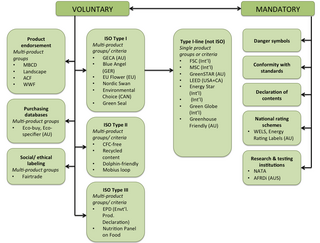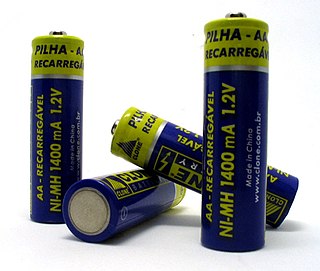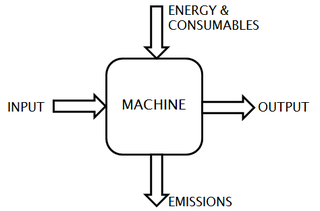
Energy conservation is the effort to reduce wasteful energy consumption by using fewer energy services. This can be done by using energy more effectively or changing one's behavior to use less service. Energy conservation can be achieved through efficient energy use, which has some advantages, including a reduction in greenhouse gas emissions and a smaller carbon footprint, as well as cost, water, and energy savings.

The Restriction of Hazardous Substances Directive 2002/95/EC, short for Directive on the restriction of the use of certain hazardous substances in electrical and electronic equipment, was adopted in February 2003 by the European Union.

EU Directive 92/75/EC (1992) established an energy consumption labelling scheme. The directive was implemented by several other directives thus most white goods, light bulb packaging and cars must have an EU Energy Label clearly displayed when offered for sale or rent. The energy efficiency of the appliance is rated in terms of a set of energy efficiency classes from A to G on the label, A being the most energy efficient, G the least efficient. The labels also give other useful information to the customer as they choose between various models. The information should also be given in catalogues and included by internet retailers on their websites.

The presence of the logo on commercial products indicates that the manufacturer or importer affirms the goods' conformity with European health, safety, and environmental protection standards. It is not a quality indicator or a certification mark. The CE marking is required for goods sold in the European Economic Area (EEA); goods sold elsewhere may also carry the mark.

Ecolabels and Green Stickers are labeling systems for food and consumer products. The use of ecolabels is voluntary, whereas green stickers are mandated by law; for example, in North America major appliances and automobiles use Energy Star. They are a form of sustainability measurement directed at consumers, intended to make it easy to take environmental concerns into account when shopping. Some labels quantify pollution or energy consumption by way of index scores or units of measurement, while others assert compliance with a set of practices or minimum requirements for sustainability or reduction of harm to the environment. Many ecolabels are focused on minimising the negative ecological impacts of primary production or resource extraction in a given sector or commodity through a set of good practices that are captured in a sustainability standard. Through a verification process, usually referred to as "certification", a farm, forest, fishery, or mine can show that it complies with a standard and earn the right to sell its products as certified through the supply chain, often resulting in a consumer-facing ecolabel.
The best available technology or best available techniques (BAT) is the technology approved by legislators or regulators for meeting output standards for a particular process, such as pollution abatement. Similar terms are best practicable means or best practicable environmental option. BAT is a moving target on practices, since developing societal values and advancing techniques may change what is currently regarded as "reasonably achievable", "best practicable" and "best available".
Type approval or certificate of conformity is granted to a product that meets a minimum set of regulatory, technical and safety requirements. Generally, type approval is required before a product is allowed to be sold in a particular country, so the requirements for a given product will vary around the world. Processes and certifications known as type approval in English are often called homologation, or some cognate expression, in other European languages.

The Directive 2006/66/EC of the European Parliament and of the Council of 6 September 2006 on batteries and accumulators and waste batteries and accumulators and repealing Directive 91/157/EEC, commonly known as the Battery Directive, regulates the manufacture and disposal of batteries in the European Union with the aim of "improving the environmental performance of batteries and accumulators".

The energy policy of the European Union focuses on energy security, sustainability, and integrating the energy markets of member states. An increasingly important part of it is climate policy. A key energy policy adopted in 2009 is the 20/20/20 objectives, binding for all EU Member States. The target involved increasing the share of renewable energy in its final energy use to 20%, reduce greenhouse gases by 20% and increase energy efficiency by 20%. After this target was met, new targets for 2030 were set at a 55% reduction of greenhouse gas emissions by 2030 as part of the European Green Deal. After the Russian invasion of Ukraine, the EU's energy policy turned more towards energy security in their REPowerEU policy package, which boosts both renewable deployment and fossil fuel infrastructure for alternative suppliers.
The Energy Performance of Buildings Directive is the European Union's main legislative instrument aiming to promote the improvement of the energy performance of buildings within the European Union. It was inspired by the Kyoto Protocol which commits the EU and all its parties by setting binding emission reduction targets.

Various governments have passed legislation to phase out manufacturing or importation of incandescent light bulbs for general lighting in favor of more energy-efficient alternatives. The regulations are generally based on efficiency, rather than use of incandescent technology. However, it is not unlawful to continue to buy or sell existing bulbs, which are unregulated.
Ecological design or ecodesign is an approach to designing products and services that gives special consideration to the environmental impacts of a product over its entire lifecycle. Sim Van der Ryn and Stuart Cowan define it as "any form of design that minimizes environmentally destructive impacts by integrating itself with living processes." Ecological design can also be defined as the process of integrating environmental considerations into design and development with the aim of reducing environmental impacts of products through their life cycle.
The End of Life Vehicles Directive is a Directive of the European Union addressing the end of life for automotive products. Every year, motor vehicles which have reached the end of their useful lives create between 8 and 9 million tonnes of waste in the European Union. In 1997, the European Commission adopted a Proposal for a Directive to tackle this problem.
Environmental issues in the European Union include the environmental issues identified by the European Union as well as its constituent states. The European Union has several federal bodies which create policy and practice across the constituent states.

The common external power supply was a European Commission (EC) specification for a universal charger for smartphones sold within the European Union. The specification included the use of a USB Micro-B connector and adherence to the USB Battery Charging Specification.
The European Pump Manufacturers Association, mostly known as Europump, is the European association for pump manufacturers.
ErP, energy-related products, are products that use energy, or that do not use energy but have an indirect impact on energy consumption, such as water using devices, building insulation products, windows, etc. Compared to ErP, energy-using products (EuP) are products which are dependent on energy input . All ErP and EuP are subject to energy efficiency requirements.
Energy efficiency in agriculture refers to reducing the amount of energy required to provide agricultural products and services. The European Commission has policies related to energy efficiency, including in agriculture. The European Union has established measures to promote energy efficiency, including setting targets for energy savings, and requiring energy audits and management plans for large companies. The AGREE project conducted studies on energy efficiency in different agricultural production systems and proposed measures for improvement. The results of the project were summarized in reports that highlighted the opportunities and drawbacks for energy efficiency in agriculture in different European countries. Improving energy efficiency in agriculture contributes to reducing greenhouse gas emissions.

Ecomechatronics is an engineering approach to developing and applying mechatronical technology in order to reduce the ecological impact and total cost of ownership of machines. It builds upon the integrative approach of mechatronics, but not with the aim of only improving the functionality of a machine. Mechatronics is the multidisciplinary field of science and engineering that merges mechanics, electronics, control theory, and computer science to improve and optimize product design and manufacturing. In ecomechatronics, additionally, functionality should go hand in hand with an efficient use and limited impact on resources. Machine improvements are targeted in 3 key areas: energy efficiency, performance and user comfort.









